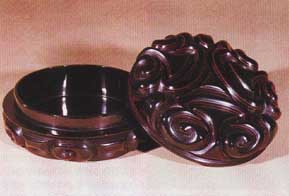Carved Black Lacquer Box, made by Zhang Cheng of the Yuan Dynasty (1271-1368), is a representative of carved lacquer wares of that period. The lacquer box is 6 cm in height as a whole and 14.5 cm or so in width. It looks like an arched roof and its body is in the shape of a column.
 |
|
The box adopted the technique of lacquer carving. During the making process, the box was first painted with black lacquer over one hundred times. After the black lacquer formed a color layer, it was painted with red lacquer several times. Repeated this way over and over again until the lacquer layers reached the needed thickness, the artisan carved the box with cloud patterns in alternating red and black layers of lacquer until three red lines appeared on the section of lacquer layers. The box has three groups of cloud patterns on its cover and body. This carved lacquer ware is now preserved in the Anhui Provincial Museum. The work is of primitive simplicity and full of elegance, having very high artistic value and representing the highest level of China's lacquer carving technique.
Chinese carved lacquer probably dates back to the Tang Dynasty (618-907). As noted in theTreatise on Lacquer Decorationby an artisan of the Ming Dynasty (1368-1644), Tang lacquer ware was done on smooth boards using a vermilion color… Special lacquer ware workshops were set up in the Ming Dynasty, producing pieces distinguished for bold, simple lines and rich colors. Works of the Qing Dynasty (1644-1911), on the other hand, are known for their detailed designs and elaborate composition.
The Jingzhai Workshop, established in 1901 in Beijing, worked for many years in the Qing style. Over the past 40 years or so, the craftsmen there have begun to experiment with deep relief carving, hollowing and three-dimensional techniques. More than 20 colors are now used, a great change from the traditional four. A handful of factories in the Beijing area, with a combined work force of 20,000, produce carved lacquer ware -- both traditional items like jars, boxes writing articles, dishes and personal adornments, as well as prize-winning artistic creations.
